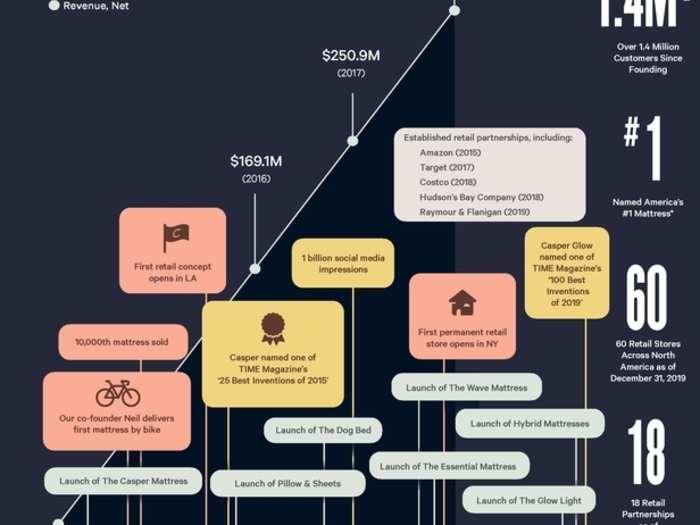
A chart shows the company's revenue growth alongside its different product offerings, growing from Casper's first mattress back in 2014. Casper now offers four mattresses, pillows and sheets, a glow light and even a dog bed. It generated $357.9 million in revenue in 2018.
The chart also highlights Casper's humble origins, like Casper cofounder Neil Parikh delivering the startup's first mattress by bike.

Casper racked up operating losses of $65 million by September 2019, roughly the same as it lost in the same period the year before.
More than 70% of its gross profit in the first nine months of 2019 were spent on sales and marketing costs.

Casper doesn't envision itself as a mattress company, positioned in a mattress market.
It is a company that aims to take advantage of an entire "sleep economy."
One of its wackier slides drums that point home, through a slide showing a timeline between bedtime and waking up.

Casper gathers data from customer website visits, customer reviews, social media, and other sources.
This graphic shows its data scientists in the middle of a chemistry lab, funneling data gathered from these sources into improving its sales and marketing experiences (which in turn, should encourage customers to give more feedback as per the graphic).

Casper envisions its offerings growing far beyond the humble mattress, to take advantage of a global market that sells sleep for pets, sleep for travelers, sleep technology and medical devices.
"The total market size of the categories and geographies we currently address is $67 billion in 2019, leaving significant opportunity for growth," the company says. This graphic shows how it aims to grow its offerings in the future.

Not only does Casper value the global sleep market at a whopping $432 billion, but it also estimates it growing at an annual rate of 6.3% over the next five years, a rate almost twice as fast as the global economy, which grew 3.5% in 2019, the IMF said.
A chart later in the IPO shows that the domestic sleep market is also expected to grow at a rate well above the US economy's 2.1%, at 3.6%.
By 2024, Casper says the sleep market will be worth $585 billion.
 Colon cancer rates are rising in young people. If you have two symptoms you should get a colonoscopy, a GI oncologist says.
Colon cancer rates are rising in young people. If you have two symptoms you should get a colonoscopy, a GI oncologist says. I spent $2,000 for 7 nights in a 179-square-foot room on one of the world's largest cruise ships. Take a look inside my cabin.
I spent $2,000 for 7 nights in a 179-square-foot room on one of the world's largest cruise ships. Take a look inside my cabin. An Ambani disruption in OTT: At just ₹1 per day, you can now enjoy ad-free content on JioCinema
An Ambani disruption in OTT: At just ₹1 per day, you can now enjoy ad-free content on JioCinema Catan adds climate change to the latest edition of the world-famous board game
Catan adds climate change to the latest edition of the world-famous board game
 Tired of blatant misinformation in the media? This video game can help you and your family fight fake news!
Tired of blatant misinformation in the media? This video game can help you and your family fight fake news!
 Tired of blatant misinformation in the media? This video game can help you and your family fight fake news!
Tired of blatant misinformation in the media? This video game can help you and your family fight fake news!

Copyright © 2024. Times Internet Limited. All rights reserved.For reprint rights. Times Syndication Service.